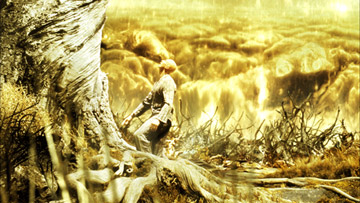THE FOUNTAIN

Reviewed by Sam Hatch
AS THIS IS PART OF A YEAR-END DISCUSSION AS OPPOSED TO A TRADITIONAL REVIEW, THERE MAY BE SPOILERS PRESENT IN THE TEXT.
Hot on the heels of his bravura performance in The Prestige came this equally impressive role for Hugh Jackman as three different variations of one man in Darren Aronofsky's (Pi and Requiem For A Dream) ambitious sci-fi triptych. Plagued by a false start and an ever-shrinking budget, Aronofsky was forced to recast his project and trim it severely (a graphic novel adaptation of the earlier script intended for Brad Pitt and Cate Blanchett is available), though it still remains as a dense, difficult work.
The story takes place in three distinct time periods that aren't laid out in a linear fashion, but live and breathe together in the fashion of the Buddhist 'Now', in which all time takes place at the same time. The earliest incarnation of Jackman's character Tomas is as a Spanish conquistador doing battle with Mayans at the behest of Rachel Weisz's Isabel, Queen of Spain. He quests for the fabled tree of life, a search which is mirrored in the second timeline as he portrays Dr. Thomas Creo, a biologist looking for a cure for aggressive brain tumors. His feverish drive is fueled by the fact that his wife Izzy (Weisz again) is dying from such a brain tumor, and the clock is ticking. The tree of life motif is introduced again, as a mysterious sample from a South American tree is used to cause miraculous anti-aging properties in a test monkey. The amazing nature of this experiment means nothing to Creo without the healing of the tumor, and he is so driven to cure his beloved wife that he finds himself incapable of simply being with her and loving her during her time left on Earth.
Indeed, in the third story (as he is a bald headed immortal floating through space with another symbolic tree housed in a hermetic bubble) he finds himself constantly haunted by a moment in which he denies Izzy a walk in the snow in order to continue his work. Jackman's grief is powerful, raw and believable, and one scene in which he tattoos an inky band on his finger to replace his misplaced wedding ring is incredible stuff. Once again, he essays a character that is so self involved that he treads close to the line in which he could lose the audience's sympathies.
I mentioned that the film is difficult, which it is in many ways. It's also very quiet, ambient and thought provoking. The dialogue is very subdued, and in one particularly crafty bit of sound engineering, the soundtrack disappears completely as Thomas loses himself in his own mind. The story is labyrinthine in its construction, and the second time line introduces a ‘story within a story' device in that Izzy is writing a book called 'The Fountain' that closely parallels elements of the first and last timelines. This leads one to wonder whether the middle tale is the only 'real' story, or whether or not Jackman is a true immortal who has been living since the olden days.
Visually, it's sumptuous and remarkably creative, as Aronofsky opted to escape CGI monotony by creating the nebulous space scapes with images captured from petri dish experiments. The Mayan scenes are dreamlike and simple, with claustrophobic stone corridors lit by surrealistic, beautiful starlit skies. The special effects on display when Tomas discovers that the Mayan tree of life doesn't act as one would imagine are very creative and surprising.
Like most great science fiction, there aren't that many elements of traditional sci fi trappings, and those expecting a time traveling space epic will likely be disappointed (not to mention fans of Jackman's other romantic time-bending piece Kate and Leopold). Obvious comparisons to 2001: A Space Odyssey can be drawn due to the acid trip visuals as Tommy and the Tree hurl through space. Though it's another spare, science fiction character piece that it reminds me the most of, namely Steven Soderbergh's remake of Stanislav Lem's classic Solaris. The ending is also vaguely reminiscent of Neo's final journey in The Matrix Revolutions (except it doesn't suck), but once again parallels exist to Keir Dullea's final trip in 2001. No space baby, though. Space Buddha perhaps.
Special mention must also go to Aronofsky's musical partner Clint Mansell (from the defunct techno group Pop Will Eat Itself), and the Kronos Quartet (along withthe rock band Gomez) bring his haunting score to life. Luckily, if you strip the film of its rich imagery you're still left with a poignant, scarring exploration of death, grief, acceptance, faith and rebirth. No wonder most of the audience hated it and wanted their money back when I saw it.